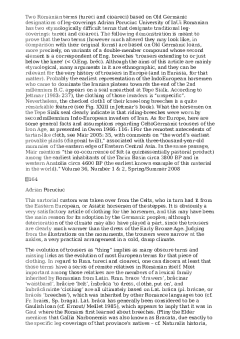Two romanian terms tureci and cioareci based on old germanic designations of leg coverings
Two Romanian terms tureci and cioareci based on Old Germanic designations of leg-coverings Adrian Poruciuc University of IaUi Romanian has two etymologically di ?cult terms that designate traditional leg- coverings tureci and cioareci The following demonstration is meant to prove that the two terms however much altered they may look like in comparison with their original forms are based on Old Germanic loans more precisely on variants of a double-member compound whose second element is a correspondent of Eng breeches ? trousers extending to or just below the knee ? O Eng bréc Although the aims of this article are mainly etymological many arguments in it are ethnographic and they can be relevant for the very history of trousers in Europe and in Eurasia for that matter Probably the earliest representation of the IndoEuropean horsemen who came to dominate the Iranian plateau towards the end of the nd millennium B C appears on a seal unearthed at Tepe Sialk According to Jettmar the clothing of those invaders is ??unspeci ?c ? Nevertheless the checked cloth of their knee-long breeches is a quite remarkable feature see Fig XXIII in Jettmar ? s book What the horsemen on the Tepe Sialk seal clearly indicate is that riding-breeches were worn by secondmillennium Indo-European invaders of Iran As for Europe here are some general facts and assumptions regarding CeltoGermanic trousers of the Iron Age as presented in Owen For the remotest antecedents of tartan-like cloth see Mair with comments on ??the world ? s earliest provable plaids diagonal twill ? associated with three-thousand-year-old mummies of the eastern edge of Eastern Central Asia In the same passage Mair mentions ??the co-occurrence of felt a quintessentially pastoral product among the earliest inhabitants of the Tarim Basin circa BP and in western Anatolia circa BP the earliest known example of this material in the world ? Volume Number Spring Summer C Adrian Poruciuc This sartorial custom was taken over from the Celts who in turn had it from the Eastern European or Asiatic horsemen of the steppes It is obviously a very satisfactory article of clothing for the horsemen and this may have been the main reason for its adoption by the Germanic peoples although deterioration of the climate may also have played a part since the trousers are clearly much warmer than the dress of the Early Bronze Age Judging from the illustrations on the monuments the trousers were narrow at the ankles a very practical arrangement in a cold damp climate The evolution of trousers as ??thing ? implies as many obscure turns and missing links as the evolution of most European terms for that piece of clothing In regard to Rmn tureci and cioareci one can discern at least that those terms have a series of remote relatives in Romanian itself Most important among those relatives are the members of a lexical family inherited by Romanian from Latin Rmn brace ? drawers ? br? cinar ? waistband ? br? cire ? belt ? ?
Documents similaires










-
40
-
0
-
0
Licence et utilisation
Gratuit pour un usage personnel Aucune attribution requise- Détails
- Publié le Aoû 02, 2022
- Catégorie Literature / Litté...
- Langue French
- Taille du fichier 103.2kB


